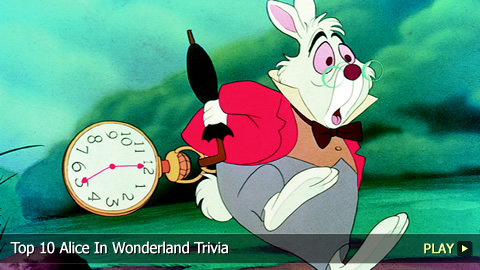Top 10 Alice In Wonderland Trivia

Two for the Price of One
Kicking off our trivia fun is a factoid about the 1951 Disney classic. Did you know that film combined the stories of the original novel and its sequel, “Through the Looking Glass”? Unfortunately, the dragon-like Jabberwock – which most people incorrectly call the Jabberwocky – was nowhere to be seen, since Disney figured the monster would scare the bejesus out of kids.
The Author
Charles Lutwidge Dodgson is not just one of the most British names we’ve ever heard; it’s also the real name of “Alice” author Lewis Carroll. Dodgson was a mathematics lecturer and tutor at Christ Church University in Oxford, England, but he suffered from stammering, epilepsy, partial deafness and ADHD. It’s a wonder he ever got this tale told, but “Wonderland” was his only success as a storyteller.
Sly Reference
Lewis Carroll’s 1865 novel began with Alice wandering off from her boring sister. With her was her cat Dinah, and the kitty’s name was taken from the song “I’ve Been Working on the Railroad.” That was, of course, a slick reference to the semi-forced labor of blacks and Chinese at the time. So, by taking a trip down the rabbit hole, Alice was, like, fighting for civil rights?
Acid Trip
Hey guess what! Disney was definitely not immune to book snobs with their 1951 animated classic: as with most book-to-film adaptations, literary fans agonized over the many inaccuracies and omissions. In fact, “Alice” only became a hit in the ‘60s thanks to hippies and their love of mind-altering substances. From then on, the story was associated with drug culture, and it’s no wonder really: there was a caterpillar that sits on a mushroom, smokes a pipe, claimed to have magic powers, and gave lessons like a freakin’ professor.
Pair of Downers
Once Alice used the potion to get through the small doorway into Wonderland, she met the twins: Tweedle Dee and Tweedle Dum. Even though they were kind of annoying, these guys seemed harmless at first. But, dig a little deeper and you got their real meaning: they represented the twin evils or, if you prefer, the two sides of depression. Bummer.
Cheshire Cat and the Queen of Hearts
Our grinning cat friend was quite the oddball character, and we know that Lewis Carroll was all about the deeper meanings. Ever wonder what the Cheshire Cat’s deal was? Turns out, he represented the shifting state of Alice’s mind and sanity, as he was constantly fading in and out.
The Queen of Hearts, on the other hand, was always demanding the removal of heads – or, in this case, the end of her hallucinations. That’s why she was so judgmental towards Alice and her behavior – she condemned her for expanding her mind, which the Queen thinks made her head “too big.”
Missing Cards
In Disney’s animated classic, the Queen of Hearts’ henchmen were carefully animated and meticulously tracked to make sure each card was properly represented. However, all the non-heart face cards were left out, signifying that she was not playing with a full deck…if you catch our drift…
The Tea Party
The tea party was another veiled substance abuse reference: the Mad Hatter and the March Hare kept changing places in an attempt to “get clean” of their alcoholism. But they quickly returned to their habits, despite their efforts to evoke change. Try rehab, boys!
Look at the Time
The White Rabbit was one dapper dude, and he wouldn’t be caught dead without his pocket watch. Of course, this represented something far more profound: the pocket watch symbolized the last sense of accuracy and objectivity in the world of Wonderland. So when it was smashed apart, Alice’s final link to reality was broken along with it, causing her to become fully lost in the fantasy, “mome raths” and all.
10/6
Rounding out our trivia list is the card that sticks out of the Mad Hatter’s hat. It read “10/6,” and this inspired fans to mark October 6th as the silliest day of the year: Mad Hatter Day. But turns out the card’s meaning was pretty simple: It was the hat’s price tag, meaning it cost ten shillings and six pence.
Enjoy our Alice in Wonderland Trivia? Have fun facts of your own? Be sure to subscribe and visit us at WatchMojo.com for more fun videos!
